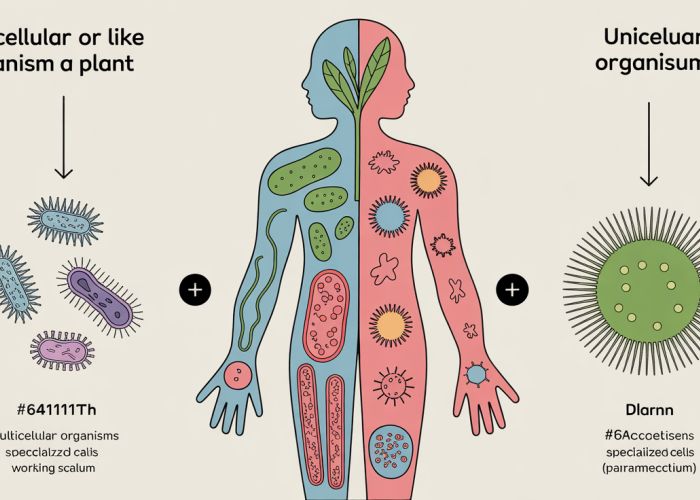Cellular biology, a fundamental aspect of life science, distinguishes organisms based on their cellular organization. Bacteria, often studied in microbiology labs, exemplify unicellular organisms, where a single cell performs all life functions. Conversely, mammals, classified within zoology, are multicellular, possessing specialized cells organized into tissues and organs. The process of cellular differentiation, crucial for multicellular development, is largely absent in unicellular life forms. Understanding the stark contrast between multicellular vs unicellular organisms sheds light on the evolutionary complexities and diverse strategies for survival found across different kingdoms of life.

Crafting the Ideal Article Layout: Unicellular vs Multicellular Organisms
To effectively explore the "multicellular vs unicellular" topic, we need a layout that clearly differentiates the organisms, highlights key differences, and presents the information in an easily digestible format. The structure below outlines a potential article flow to achieve this.
Defining Unicellular and Multicellular Organisms
This section should serve as the foundation, providing clear definitions of the core concepts.
What are Unicellular Organisms?
- Definition: Provide a concise definition of unicellular organisms as organisms composed of only one cell.
- Examples: List common examples, such as bacteria (e.g., E. coli), archaea, some fungi (e.g., yeast), and protists (e.g., Amoeba, Paramecium).
- Characteristics: Outline key features of unicellular organisms:
- Single cell performs all life functions (feeding, excretion, reproduction).
- Generally small in size (microscopic).
- Simple structure.
- Often reproduce asexually (e.g., binary fission).
What are Multicellular Organisms?
- Definition: Define multicellular organisms as organisms composed of many cells that work together.
- Examples: Provide common examples, such as animals, plants, and most fungi.
- Characteristics: Highlight key features of multicellular organisms:
- Cells are specialized to perform different functions (tissue, organ, and system levels).
- Generally larger in size.
- Complex structure with organized tissues, organs, and systems.
- Reproduce sexually and/or asexually.
Detailed Comparison: Multicellular vs Unicellular
This section will dive into the specific differences, utilizing a combination of paragraphs, bullet points, and potentially a table.
Complexity and Organization
Explain how multicellular organisms exhibit a higher level of complexity and organization due to cell specialization and differentiation. Contrast this with the simple structure of unicellular organisms.
Cell Specialization and Division of Labor
- Multicellular: Describe how cells in multicellular organisms differentiate to perform specific tasks (e.g., nerve cells transmit signals, muscle cells contract). Explain the benefits of this division of labor (efficiency, adaptation).
- Unicellular: Explain that unicellular organisms must perform all functions within a single cell, limiting their complexity and potential efficiency.
Size and Surface Area to Volume Ratio
Explain how the multicellular nature allows for larger size, and how this changes the surface area to volume ratio of the organism. Relate this to nutrient uptake and waste removal. Unicellular organisms must maintain a high surface area-to-volume ratio for efficient exchange with their environment.
Reproduction
- Unicellular: Primarily reproduce asexually, leading to rapid population growth under favorable conditions, but limited genetic diversity. Briefly explain binary fission, budding, etc.
- Multicellular: Can reproduce sexually and/or asexually, allowing for greater genetic diversity (in sexual reproduction) and adaptation to changing environments. Explain the advantage of genetic diversity.
Adaptation and Evolution
Discuss how multicellularity provides greater opportunities for adaptation and evolutionary change due to increased genetic variation and complex interactions between cells.
Evolutionary Significance of Multicellularity
This section addresses the evolutionary aspect.
The Transition from Unicellularity to Multicellularity
Briefly describe the evolutionary transition from unicellular to multicellular life. Mention theories about how this transition might have occurred, such as colonial aggregation or cell adhesion.
Advantages of Multicellularity in Evolution
Explain how multicellularity provided evolutionary advantages, such as:
- Increased size (predation avoidance, resource access)
- Cell specialization (improved efficiency)
- Complex structures (new ecological niches)
Table Summarizing Key Differences
A table provides a concise visual summary:
| Feature | Unicellular Organisms | Multicellular Organisms |
|---|---|---|
| Cell Number | One | Many |
| Complexity | Simple | Complex |
| Cell Specialization | Absent | Present |
| Size | Microscopic | Macroscopic (generally) |
| Reproduction | Primarily Asexual | Sexual and/or Asexual |
| Surface Area to Volume | High | Lower |
| Examples | Bacteria, Yeast, Amoeba | Animals, Plants, Most Fungi |
Frequently Asked Questions: Unicellular vs. Multicellular Life
Here are some common questions about the key differences between unicellular and multicellular organisms.
What is the biggest difference between unicellular and multicellular organisms?
The most fundamental difference is cell count. Unicellular organisms, like bacteria, consist of just one cell that performs all life functions. Multicellular organisms, like humans and plants, are composed of many cells working together.
How do unicellular organisms reproduce?
Unicellular organisms typically reproduce asexually through processes like binary fission, where the cell simply divides into two identical copies. Multicellular organisms often reproduce sexually, involving the fusion of gametes.
Are all single-celled organisms simple?
While often smaller and structurally less complex, unicellular organisms can still be incredibly diverse and adaptable. They perform all necessary life functions within that single cell. It’s not necessarily a matter of simple vs. complex, but rather a difference in organization.
How did multicellular life evolve from unicellular life?
Scientists believe multicellularity evolved through cooperation among unicellular organisms. Groups of these cells began to specialize and work together, eventually leading to the complex multicellular organisms we see today. Understanding this transition is crucial to understanding the differences between multicellular vs unicellular life.
So, there you have it – a glimpse into the fascinating world of multicellular vs unicellular life! Hope you found those shocking differences as interesting as we do. Keep exploring, and see what other secrets nature reveals!